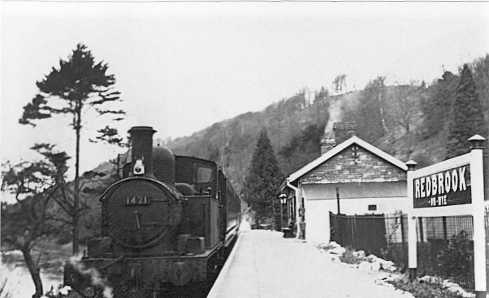
(An article written by the son of a former Vicar of Penallt)
When my father came to Penallt as Vicar in 1913, the GWR was still the only means of travel beyond Monmouth – for instance, to visit our dentist in Ross every holiday, we went by train, leaving Troy Station about 9 am and not returning until quite late in the afternoon.
Going back to school at Brecon was a whole day’s journey: Troy to Ross, where we waited for more than an hour for the train connecting Gloucester and Hereford; then at Hereford we had to wait at least two hours for the train via Hay and Talgarth, arriving at Brecon Station about tea-time. At one or other of the stations boys would go along to the engine-driver and offer him a candle to put under the boiler to see if the train could go a little faster! Luggage would be collected on a wagon and we walked to school through the town and across the bridge to Christ College. In those days boys at school never came home during the thirteen weeks of term and the train journey home was just as difficult as that made to school. In holiday time a favourite trip was to Symonds Yat, when, of course, we took the train from Redbrook or Troy to Symonds Yat.

In 1915, after one year of the war, the family had a fortnight’s holiday in Weston-super-Mare and the journey went like this: A large trunk was prepared for the family of four. Father, Mother and we two boys walked down Lone Lane to catch the morning train at Redbrook, and our ever-helpful Rushton England took the trunk in a wheelbarrow down to the river. Somehow or other we all crossed the Wye and walked to the station – which in those days was beautifully decorated with flower beds. Catching the train we went down past Whitebrook and Tintern to Severn Tunnel Junction, then on to Temple Meads [Bristol] where the station was so crowded with passengers making for Weston that we had a job to keep together. Once in the train we had to stand all the way to Weston.
In the years between the two World Wars the train continued to be the main means of transport though ‘buses and cars became more numerous. During the last World War neither my brother nor I were at home except for short leaves, though the family had moved to the Generals in 1928 and at that time it was possible to see the train coming up from Whitebrook Halt, and members of the family used to note the time of day with the passing of the train, particularly on its way up river as it made more noise than on the way down.
After the war it was my privilege to live at Portbury near Bristol and on two occasions I remember cycling from Portbury to Aust and crossing the Severn on the Ferry which carried cars and passengers across the river to Beachley. I would ride on from Beachley to Chepstow Station. Leaving the bicycle there I would take the train, booking for Redbrook. But the guard and driver were so helpful that on those two occasions they stopped the train and let me alight at the Cadora Reach, just below the Generals and I only had to walk down to Redbrook. Whichever way we travelled from Troy, the scenery was excellent but the journey either upstream to Symonds Yat or downstream to Tintern and Chepstow was superb and it is very much to be regretted that the lines were not kept open for tourists to have had the pleasure of such journeys.
[from: Penallt – A Village Miscellany]